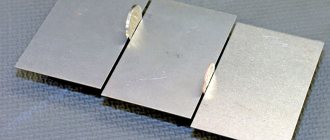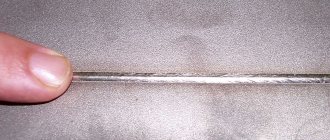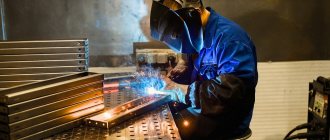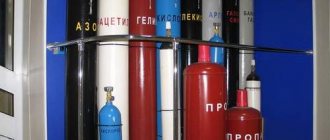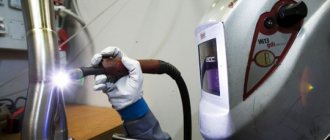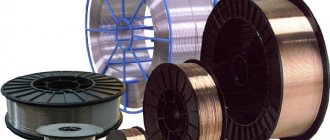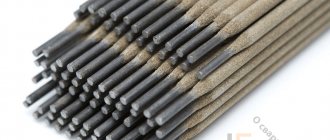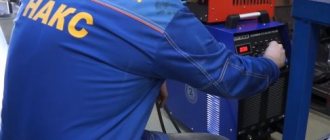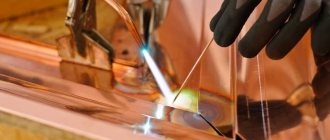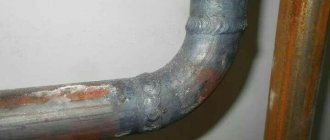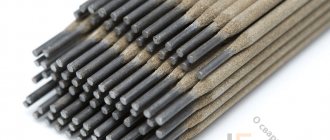Home / Consumables
Back
Reading time: 3 min
1
2377
The welding wire used in acetylene gas welding is made by many manufacturers.
The products are presented in the form of filler rods and drawn wire, with or without a sheath of non-ferrous alloys, and metal granules.
Welding material is available in the following types:
- activated - reduces spattering, improves seam quality;
- powder - allows you to obtain a seam with a composition similar to the elements being welded;
- solid section - used in the form of filler rods.
The materials allow you to work with any type of metal.
However, the diameter of the wire must not only correspond to the thickness of the product being welded, but also be similar to its chemical composition.
The material examines some types of welding material used in the process of welding and surfacing of products made of ferrous and non-ferrous metals.
- Wire for steel
- Welding of aluminum and copper alloys
- Welding cast iron
- Nuances of use
Wire for welding steels
Most often, filler wire is purchased in stores for gas welding of steels. Note that this wire is manufactured according to the same standards as for arc welding. Therefore, there is no difference between wire for gas and for RDS welding. For ordinary welding of most types of steel, wire made from low-carbon and alloy steel is used. For welding critical and especially critical structures, it is recommended to use low-alloy wire.
If you need to achieve the best quality of welds or surfacing seams, then use manganese and silicon-manganese wires. These include brands Sv-08GS, Sv-08GA, Sv-08G2S, Sv-10G2. When using these brands, the seams are strong and reliable. They are resistant to mechanical damage.
When working with low-alloy steel, purchase the same low-alloy wire, but with chromium content. The resulting seams have a high tensile strength. But when welding high-alloy steel, wire should be selected with a similar chemical composition.
Types of fluxes for gas welding
Gas welding of copper, aluminum, magnesium and their alloys is accompanied by the active formation of oxides on the surface of the metals being welded under the influence of oxygen contained in the air. Refractory oxides significantly complicate the welding process.
In order to protect metals from oxidation during welding, fluxes for gas welding are used, which are special welding powders or pastes. Boric acid and calcined borax are used as fluxes. They are applied to the edges of the metal being welded, to the welding wire and rods. At welding temperature, low-melting fluxes form slags that float to the surface of the molten metal and protect it from oxidation.
For those who constantly weld using manual arc welding, the relevant question is how to weld with a semi-automatic machine. Creating a resistance welding machine with your own hands will help you save a tidy sum. You will find detailed instructions in this article.
Do you want to weld aluminum or copper? There is an alternative way! More details at the link.
Wire for welding aluminum and its alloys, copper and its alloys
Aluminum welding wire, as well as wire made of aluminum alloys, is manufactured in accordance with GOST No. 7871-75. To work with aluminum, we recommend using the brands Sv-AK-5, Sv-A1 and Sv-AMts. The composition of the wire should be similar to the composition of the part.
For welding copper and copper alloys, wire manufactured according to the GOST standard No. 16130-90 is used. We recommend using wire grades M1 or MSr1. You can also use filler rods of the M1r and M3r brands.
To work with other non-ferrous metals (for example, bronze or brass), use wire with the same composition as the part itself. In this case, the brand of wire is not so important.
Welding wire for gas welding of cast irons
Cast iron filler rods for gas welding and surfacing are manufactured in accordance with the requirements of GOST 2671. Cast iron rods are manufactured in two grades: grade A, used for hot welding, with general heating of the entire welded product, and grade B, which is used for welding with local heating and for the manufacture of electrode cast iron rods.
In addition to these grades, there are grades of cast iron rods NC-1 and NC-2, which are used in the case of low-temperature gas welding of cast products, as well as grades BC and HC, which are used for wear-resistant surfacing.
Features of application
Before use, welding wire for gas welding with acetylene (or any other flammable gas) must be thoroughly cleaned of dirt, oil, traces of corrosion, paint, scale, etc. Form the seams slowly and evenly. Avoid splashing metal while welding. After cooling, the seam bead should be smooth and uniform in appearance. The presence of defects (pores, cracks, slag inclusions, etc.) is not allowed. Watch out for refractory oxides; they should not get into the weld pool. And most often they enter the welding zone with filler material. The oxides themselves are formed due to the reaction of nitrogen with oxygen. Their melting point is higher than that of the base metal. For this reason, the seams become uneven and of poor quality.
Types of flammable gases used
Cylinder
Gas welding of non-ferrous metals and carbon steels is most often carried out using acetylene. This is due to the high flame temperature and good combustion heat. Acetylene is a gas with a characteristic odor, which is imparted by the impurities of hydrogen fluoride and hydrogen sulfide present in it. When heated to 500 degrees and at certain concentrations in mixtures with oxygen and air, acetylene becomes explosive. Acetylene is formed by the reaction of calcium carbide with water. Calcium carbide itself is formed by the fusion of burnt lime and coke.
Petroleum and pyrolysis gases can be used as combustibles. They are gas mixtures formed during the thermal decomposition of oil and its products. They are used for welding, cutting and soldering steel parts with a thickness not exceeding 3 mm, and for welding non-ferrous metals and their alloys. Natural gas is a product of the development of gas fields and consists of 93-99% methane.
Balloon
Technical propane and propane-butane mixture are by-products during the extraction and processing of oil and natural petroleum gases. They are used when welding parts with a thickness of up to 6 mm, in some cases - up to 12 mm. Using these gases, you can weld and solder cast iron, non-ferrous metals and alloys, carry out oxygen and oxygen-flux cutting, surfacing, and spraying of plastics.
Welding metal at home using hydrogen has become possible thanks to the development of special electrolysers that can operate from both a two-phase and three-phase home network. In these devices, water is decomposed into oxygen and hydrogen, and in the proportions necessary for the welding process. The size range of produced electrolysers allows us to cover almost all types of gas welding, soldering, surfacing, powder coating, manual and machine oxygen cutting. Devices of varying power allow for micro-welding and micro-soldering, as well as cutting sheet steel with a thickness of about 300 mm.
Varieties
Acetylene welding wire must be selected for each type of part being welded. The quality of the result obtained greatly depends on this.
- Copper plated . Copper coating reduces contact resistance and protects the wire surface from mechanical damage. Ensures uninterrupted operation of equipment. Guarantees minimal metal spattering.
- Non-copper-plated . Used when working with parts made of low-carbon steel.
- Powder . It is a tube made of low carbon steel. Inside it is filled with special powders, which are deoxidizers and slag-forming substances. Along with the metal, flux may be contained inside the tube. Typically used for automatic welding. The formation of slag is minimal, which makes it easy to separate the slag crust.
- Solid section . Can be used for the manufacture of electrodes. It is independently used for welding in an automatic or semi-automatic way.
- Activated . It has the shape of a tube, but there is a small amount of powder inside. The role of activators is performed by various types of oxidizing agents.
- Gas welding . Used for welding with types of steel such as carbon and low carbon.
- Aluminized . Used for welding aluminum structures in semi-automatic mode. Helps reduce joint porosity.
- Made of stainless steel . Used for welding stainless steels.
- Flux . Used for welding steel of various grades using a semi-automatic method.
- Alloyed . Provides the ability to weld in various gases.
Welding wire for acetylene welding is selected depending on the grade of material of the product being welded in order to obtain a good quality seam.
Pros and cons of gas welding
This method of joining metals, such as gas welding, involves melting the materials being joined, resulting in the formation of a homogeneous structure. The combustion of gas, due to which the metal is heated and melted, is ensured by introducing pure oxygen into the gas mixture. This method of joining metals has a number of advantages.
- This welding method does not require the use of complex equipment (welding inverter or semi-automatic machine).
- All consumables for such welding are easy to purchase.
- Gas welding (and, accordingly, gas welding of pipes) can be performed even without a powerful energy source and sometimes without special protective equipment.
- The process of such welding can be easily regulated: you can set the required burner flame power and control the degree of heating of the metal.
This method also has disadvantages.
- The metal heats up very slowly, unlike using an electric arc.
- The heat zone that is formed by the gas burner is very wide.
- It is very difficult to concentrate the heat created by a gas burner; it is more dispersed compared to the electric arc method.
- Gas welding can be classified as a fairly expensive method of joining metals when compared with electric arc welding. The cost of oxygen and acetylene consumed significantly exceeds the cost of electricity spent to weld similar parts.
- When welding thick metal parts, the speed of the connection is significantly reduced. This is due to the fact that the heat concentration when using a gas burner is very low.
- Gas welding is difficult to automate. Only the process of gas welding of thin-walled pipes or tanks, which is performed using a multi-flame torch, can be mechanized.
Gas welding of a pipe from the bottom position
Fundamentals of theoretical training of gas welding specialists
For students studying the course “Gas Welding Technology”, an abstract can be prepared using the following literature:
- Glizmanenko D. A. “Gas welding and cutting of metals”;
- Bagryansky K.V. “Theory of welding processes”;
- Gevorkyan V. G. “Fundamentals of welding.”
For the “Gas Welding” course, the abstract should reflect the following main points:
- purpose, advantages and disadvantages of this type of creation of permanent connections;
- materials necessary for the welding process;
- equipment and apparatus used;
- main technological aspects of gas welding.
How to replace carbon dioxide for a semi-automatic machine
The very idea of converting a semi-automatic burner for propane is already dangerous. This cannot be done for a number of reasons. And the point is not so much the danger of explosion as the fact that when propane burns, it forms many other completely unnecessary components besides carbon dioxide.
Therefore, the best solution to the question of what can replace carbon dioxide is flux-cored wire. Below we will look at its advantages, but in the meantime, let’s look at why exactly you shouldn’t give up carbon dioxide when welding semi-automatically in a protective gas environment.
Purpose and scope
The use of a gas welding machine allows you to carry out the following operations:
- welding of various parts;
- soldering (including repair of damaged products);
- surfacing;
- cutting sheet metal and pipes into separate pieces.
The advantages of gas welding make it possible to use it in construction, industrial production, public utilities, car repair, and when solving everyday problems in dachas and country houses. Gas welding can join almost any material. It is used when connecting assemblies of products made of non-ferrous metals, thin-walled pipes, and elements of complex structures. With the right selection of conditions and solder, it is possible to weld cast iron and fuse brass onto its surface. Connecting and cutting metal elements allows you to obtain the required result of good quality.
Soldering is carried out by heating the parts being soldered and melting the solder with the addition of flux. In this case, surface diffusion occurs at the joints of the part with the molten solder. After cooling, a reliable and aesthetic seam is obtained that can be processed.
Surfacing is intended for applying a metal of a different type or structure to the surface of the main product. In this case, the surface being treated is heated to the so-called fogging temperature. This method restores worn parts, increases their size, and deposits material with higher strength and wear characteristics. The use of surfacing increases the service life of parts, reduces the consumption of scarce materials, and reduces the cost of repairs.
How to choose gas depending on the type of metal
The correct choice of the required gas is mainly influenced by the thickness of the sheet of metal with which to work. This choice can be easily made by referring to the appropriate tables. They are compiled on the basis of calculations and taking into account the experience of using gases in various conditions. For example, to weld carbon steel sheets, it is advisable to use a mixture of argon and carbon dioxide followed by the addition of oxygen.
Do you have experience with gas welding? Be sure to share it in the comments to this article!
General safety rules
When performing welding work, safety rules must be observed. Only serviceable equipment may be used. The work place must be at least 10 m from the source of open fire.
We recommend reading: What is automatic welding
The post must be equipped with individual means for extinguishing fires. If only acetylene is used, then a carbon dioxide fire extinguisher or sand is required.
Water should not be used to extinguish fires caused by this substance. If there is a fire, you need to bend the hose in the area of the gearbox, and then close all the valves.
